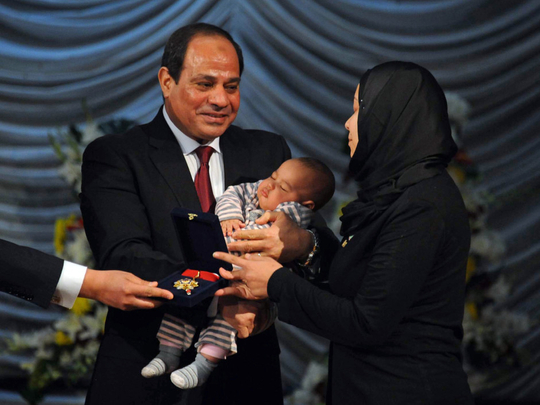
Anti-Mubarak uprising
On January 25, 2011, massive anti-Mubarak protests erupt after a revolt topples Tunisia’s ruler in what becomes known as the Arab Spring.
On January 28, increasing numbers of demonstrators take to the streets across the country in what is known as the ‘Friday of Rage’. Thousands of the protesters converge on Cairo’s Tahrir Square as Mubarak’s police system eventually shows signs of collapse.
On February 11, Mubarak resigns and hands power to the army, which suspends the constitution and dissolves parliament.
About 850 people die during 18 days of revolt, according to an independent fact-finding commission.
In August, 2011, Mubarak and his interior minister Habib Al Adli appear for trial at a criminal court on charges of involvement in killing the protesters.
On June 1, Mubarak and Al Adli are sentenced to life in prison, a verdict revoked later on appeal. While Al Adli is eventually acquitted, Mubarak faces a retrial. Egypt’s top appeals court is expected to deliver a final ruling on April 7.
Islamist victory
From November 2011 to January 2012, Egypt holds post-revolt parliamentary elections. Islamists win about two-thirds of the seats, half of which go to the Muslim Brotherhood. In June, the parliament is dissolved when a court rules it is illegal.
On June 30, 2012, Brotherhood candidate Mohammad Mursi becomes president after winning the election with 51.7 per cent of the vote. He becomes Egypt’s first freely elected civilian and Islamist leader.
In August, Mursi replaces defence minister Hussain Tantawi with military intelligence chief Abdul Fattah Al Sissi.
Mursi ousted, Al Sissi in power
On July 3, 2013, the army, then led by Al Sissi, deposes Mursi after massive protests against his one-year rule, and freezes the Islamist-drafted constitution. Mursi is taken into detention as authorities launch a crackdown against his supporters.
On August 14, security forces move to disperse two pro-Mursi protest camps in Cairo, leaving hundreds dead including civilians and policemen.
Tens of thousands of Mursi’s supporters have been arrested since and hundreds, including Mursi himself, have been sentenced to death.
In December, the government declares the Brotherhood a “terrorist” organisation.
In January 2014, voters overwhelmingly approve a new constitution.
On June 8, Al Sissi is sworn in as president having won 96.9 per cent of a vote boycotted by the Brotherhood.
On January 10 2015, a new parliament dominated by Al Sissi’s backers, holds its inaugural session, becoming Egypt’s first legislature in more than three years
Militant unrest, economic accords
On February 10, 2015, during a visit to Cairo by President Vladimir Putin, Egypt and Russia agree to jointly build Egypt’s first nuclear power plant.
On February 16, Cairo carries out air strikes against the Daesh terror group in neighbouring Libya after a graphic video is released showing the beheading of 21 Egyptian Coptic Christians there.
On March 13, Al Sissi opens a major economic conference during which Gulf allies pledge $12 billion (Dh44.05 billion) in aid to prop up Egypt’s economy.
On June 29, Egypt’s chief prosecutor Hesham Barakat is killed in a car bombing near his house in Cairo.
On August 6, Al Sissi inaugurates an expansion to the Suez Canal at a ceremony attended by world leaders and dignitaries.
On October 10, Egypt signs a deal with France to buy two Mistral warships.
On October 31, a Russian passenger plane blows up in the Sinai, killing all 224 people on board. Daesh claims responsibility. The crash deals yet another blow to Egypt’s ailing tourism sector.
On December 16, Saudi Arabia pledges a total of $8 billion in investment and aid to Egypt, along with petrol supplies over the next five years.
On January 21, 2016, Chinese President Xi Jinping signs economic deals worth $15 billion with Egypt.












